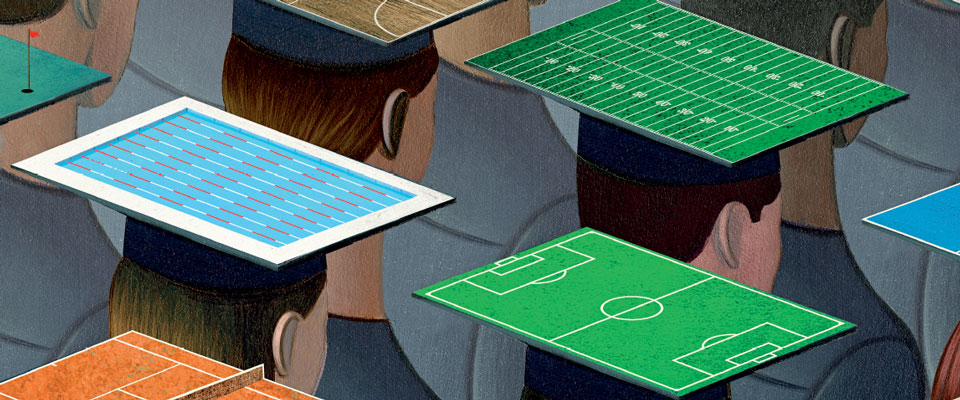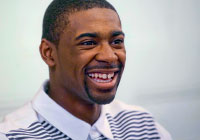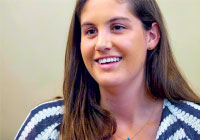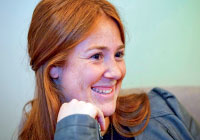Commitment, Competition, Connection

By Robert J. Bliwise ’76 | ILLUSTRATION BY JON KRAUSE
Imagine assembling a Lafayette dream team of student-athletes. Who might it include? Maybe Joanna Scotti ’17 (soccer), Jarrel Bobb ’16 (track and field), Seth Hinrichs ’15 (basketball), Mark Dodd ’16 (football), and Jane Kuntz ’15 (swimming).
And what would you learn from listening to them? One not very surprising insight is that in the past academic year, a couple of them found themselves performing very much in the spotlight. In March, the men’s basketball team, playing in Kirby Sports Center, won the Patriot League tournament title with a 65-63 victory over American University. And earlier, in November, Lafayette swept past Lehigh, 27-7, in the 150th meeting of the most-played rivalry in college football, held, on this occasion, in Yankee Stadium. As The New York Times reported, pregame, “The athletic directors are speaking proudly of the rivalry because of the caliber of students who have played football at the colleges through the years.”

My goal was always to play Division I, and as I started talking to colleges, it turned into the goal of playing for Lafayette.
—Seth Hinrichs ’15
Whether in or out of the spotlight, these players, like other Lafayette students, say they were drawn to a small college with strong academics. But participating in their sport of choice, at the Division I level, was instrumental in their decision to attend Lafayette. They all largely echo Hinrichs’ sentiment (even if they don’t necessarily share his ambition of a post-Lafayette stint in professional sports): “My goal was always to play Division I basketball, and as I started talking to colleges, it turned into the goal of playing for Lafayette.”
From the start, they all managed to bond instantly and enduringly with their teammates. “We’re not a scholarship sport, but everyone on the team is committed to swimming,” says Kuntz. “We’re pushing at a really high level, for the love of the sport. It’s all about the pursuit of excellence. Everything I do I try to do to the best of my ability.” A talk with Jim Dailey, her future swimming coach at the College, she says, persuaded her that “I could swim here at a competitive level and get a great education. I hadn’t thought about Lafayette before. But then I decided it was the place for me.”
Their lives as student-athletes have been especially busy: practicing, conditioning, watching game films, traveling for competitions, often devoting time to community service, and, of course, handling an academic workload across the College’s curriculum—government and law, biology, economics, psychology, Spanish.
As Dodd puts it, “Studying and absorbing every aspect of the game can feel like a course added onto your curriculum—it takes as much mastery as a course. But it’s what you signed up to do.” Adds Scotti, who was sold on Lafayette in part by walking through Skillman Library and perceiving a strong dedication to academic accomplishment: “Being so involved in a sport has certainly helped me manage my time. You’re always thinking about the next game and how you should prepare. But you have to turn that off. You have to turn yourself on to writing that paper or to finishing that problem set.”
Bobb, who as a student-athlete prospect was torn between running track and playing soccer, mentions his routine around weekend track meets: searching out a quiet spot and grabbing reading and studying time. Those meets would typically extend from early morning right through the evening. And Hinrichs says, half-jokingly, that the most stressful part of his college years came during the off-seasons: “I just wasn’t used to having all that freedom, all that unstructured time.”
Significant Impact
The structure of Lafayette’s athletic program reflects its membership in the Patriot League, of which it’s a charter member. In its mission statement, the league commits itself to being “recognized nationally for the effective integration of Division I athletics into the educational mission of the institution.” Lafayette’s Division I standing is unusual for a relatively small liberal arts college. So is its range of athletic offerings. The College has 23 Division I varsity sports: 11 for men, 11 for women, and one, fencing, that is coed. Just over 22 percent of the student body participates, which comes to something like 600 students.

His routine around weekend track meets: searching out a quiet spot and grabbing reading and studying time.
—Jarrel Bobb ’16
That’s a lot of participation. Bruce McCutcheon, director of athletics, says the program requires “significant resources” but has a significant impact. “I like to say that this is an institution of higher education, not just an institution of higher academics. We’re educating students through the classroom and lab but also through residence halls, clubs and activities, and social events. That’s why we fund an athletics program. Just as students can grow and achieve at the highest level in the classroom or on the forensics team, they can learn, grow, and achieve at the highest level on the court, on the field, on the track, or in the pool.”
For the most recent seasons in men’s basketball and football especially, that learning, achieving, and growing has been happening in high-pressure, high-profile settings. Still, McCutcheon says Lafayette athletics isn’t a business or an entertainment venture. When he’s interviewing prospective coaches, McCutcheon impresses on them their responsibility to serve as teachers—teachers concerned with lessons of leadership, teamwork, and time management. He notes that the Leopards annually rank among the nation’s best in its student-athlete graduation success rate (GSR) as measured by the NCAA. This past fall, it boasted a 97 percent GSR overall for the 18 sports measured; 12 Lafayette programs registered a graduation rate of 100 percent.
All of that sits well with Fran O’Hanlon, who just finished his 20th year as men’s basketball head coach—and who, in that role, just led Lafayette to its third league title. At the end of the past academic year, O’Hanlon was honored with the Maroon Club Athletic Staff Achievement Award, given to a full-time athletics department staff member who has demonstrated outstanding service to the College and its athletics program.
In his recruiting, O’Hanlon considers character as “playing a very important role,” along with a clear focus on academics, a good work ethic, and leadership potential. He stresses that “your basketball experience will be excellent. Just ask the student-athletes who are here or who were here—they are our best recruiters.” More than that, he tells them, “You are going to a terrific school” where the faculty cares about student development, where students will receive the faculty’s full focus and enthusiastic guidance. “And this is not just a four-year decision but a 40-year decision. It offers you a terrific network as you graduate.”
“I want them to have a very positive experience, to develop to their full potential, and to come away with lifetime friendships,” says O’Hanlon. “The aim of our program is to leave it better than you found it. What are you going to add each day, each year, that will make it better?”

We’re not a scholarship sport, but everyone on the team is committed. We’re pushing at
a really high level.
—Jane Kuntz ’15
For The Better
O’Hanlon notes that Lafayette, in his time on campus, has undergone shifts to make the sports scene better. Some of those shifts are in facilities, including the expansion of Kirby Field House into Kirby Sports Center, the transformation of Fisher Stadium, the dedications of Kamine Varsity House and Kamine Stadium, and the renovation of the sports center’s arena, to name just some. And some of the shifts, certainly with an impact on recruiting, come from the trustee vote, in 2006, to award merit-based athletic scholarships. Initially those scholarships were in men’s and women’s basketball.
Before that decision, Lafayette had been the only Patriot League member that was not awarding financial aid above need in any sport. The College now awards athletic scholarships in 11 sports—along with men’s and women’s basketball, those are baseball, field hockey, football, men’s and women’s lacrosse, men’s and women’s soccer, softball, and volleyball.
O’Hanlon’s counterpart in women’s basketball is Theresa Grentz, who is about to begin her first year as coach after serving as an assistant coach last year. Grentz was hired as the first full-time women’s basketball coach in the nation at Rutgers in 1975. Her deep experience in coaching includes leading the U.S. Olympic Team, and she has been inducted into the Women’s Basketball Hall of Fame. “I came here and fell in love with the place,” she says. She’s drawn to working with individuals who “aren’t afraid to succeed” and who look to academic endeavors as an opportunity rather than a stumbling block, as she puts it. Every student who ever played for her has graduated.
“I push them as student-athletes,” Grentz says. “I’m a taskmaster.” She aims to recruit student-athletes who will want to work with the coaching staff, she adds, to deepen their self-confidence, to step out of their comfort zone, and “to be the best version of themselves. I want to know about them 10 years after they graduate: What are they doing? How successful are they in life? That’s the greatest thing about coaching.”

You have to turn yourself on to writing that paper or finishing that problem set.
—Joanna Scotti ’17
Lafayette President Alison Byerly says she admires the model of the coach-educator. A conspicuous presence at numerous athletic events, she says the relatively limited range of athletic scholarships, as one tool in the recruiting process for those coach-educators, “seem to be doing what we hoped they would do,” including upholding the academic criteria expected for admitted students. “It’s not possible for every team to be a championship winner every year,” she adds. “But I like to imagine every team in the running for that kind of success.”
Byerly says she also appreciates the symbolic importance of sports at Lafayette. “Sports can represent a bridge between the College of the past and the College of the present. Even as Lafayette is very forward-looking, sports loom large in the picture that many alumni have of Lafayette from their days as students, and it’s an area where they can readily show their loyalty.”
Close Ties
Byerly sees sports participation feeding into one forward-looking theme, the College’s “Connected Communities” initiative, which aims for a more fully integrated student experience. A task force she appointed to explore ways of creating a more connected campus called for “opportunities for students to acquire and practice leadership skills, and establish a strong sense of community among a diverse student body.” Participation on a team, according to Byerly, is one place for nurturing those values.

Absorbing every aspect of the game takes as much mastery as a course. But it’s what you signed up to do.
—Mark Dodd ’16
She notes the close ties to the College forged by sports. This past year’s senior class pledge drive produced an unusually enthusiastic response; the commitment on the part of student-athletes was 100 percent. She’s run into a good number of former student-athletes among the College’s most avid supporters. She’s observed, too, how sports serve as “a critical piece of the social fabric that ties the campus together. One thing a lot of people find attractive about Lafayette is the school spirit we have here. You see that every day on campus with students wearing their Lafayette-imprinted shirts. Athletic competition isn’t the only force behind that. But it’s clear that people take pride in what our students and our coaches accomplish.”
“Given the size of the student body and the academic expectations, Lafayette will invariably find it challenging to compete at the Division I level,” says Byerly. “But Lafayette competes in many different arenas. We compete with schools with more resources, with larger endowments. That doesn’t mean we walk away from such competition.”
With that statement, she reaches, appropriately enough, for a sports metaphor: “Sports participation is another place where we’re very good at punching above our weight.”
Bliwise ’76 is editor of Duke Magazine and teaches magazine journalism at Duke University.